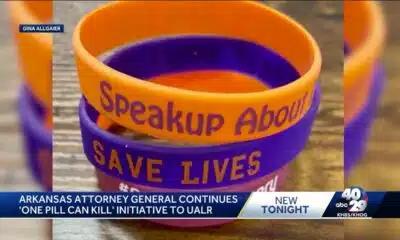Kaiser Health News
Lawsuits Claim South Carolina Kids Underwent Unnecessary Genital Exams During Abuse Investigations
Lauren Sausser
Thu, 22 Feb 2024 10:00:00 +0000
Warning: Some readers may find graphic details in this article to be offensive or disturbing.
CAMDEN, S.C. — Three ongoing federal lawsuits filed in South Carolina accuse the state of forcing boys and girls to undergo traumatic genital exams during child abuse investigations, even when no allegations of sexual abuse have been raised.
One 14-year-old plaintiff — who goes by “Jane Doe” to protect her privacy — was placed into foster care in 2021 after she disclosed to a social services caseworker that her mother had spanked her with a belt and a tree branch.
“I never, ever mentioned sexual abuse,” said Jane, who was 12 when the South Carolina Department of Social Services launched its investigation and scheduled her to undergo a forensic medical exam at a hospital in Columbia. “I felt like I was kind of getting legally abused by someone that had the permission to do it,” she told KFF Health News during an interview at her attorney’s office.
During the exam, Jane was instructed to undress and open her legs in front of medical providers she’d never met before who took photos of her genital area, touched her breasts, and placed “fingers and/or instruments” in her vagina, according to her lawsuit.
“I felt like I had no right to say no,” she told KFF Health News. “Something inside me told me that wasn’t what they were supposed to do.”
Connelly-Anne Ragley, a spokesperson for the department, would not discuss the ongoing lawsuits. Court filings show the agency denies the allegations and argues that its employees are protected by “qualified immunity,” a type of court-created rule that often shields law enforcement officers and government officials from being sued. The department also asserts that forensic exams are “standard procedure” during abuse and neglect cases.
Investigating child abuse is notoriously complex. The investigations usually involve forensic interviews, which are typically recorded and involve a professional asking questions of a child to elicit information. And they sometimes include forensic full-body medical examinations that include a visual check of the child’s private parts and are designed to be noninvasive, meaning medical tools that can break the skin or enter the body are not used.
Together, the interview and the exam are considered effective tools for gathering information and evidence from underage victims, who may be reluctant to describe or disclose how they’ve been hurt. Often, these interviews and exams are conducted at children’s advocacy centers by social workers, doctors, and nurses who are specially trained to treat young patients with sensitivity and care — and learn to read between the lines.
Federal guidelines advise that the mere suspicion of child sexual abuse should be sufficient to trigger a forensic medical exam. Even so, there’s a growing consensus in medicine that genital and pelvic exams can be embarrassing, uncomfortable, and even traumatic.
The South Carolina lawsuits — which involve children who live in different parts of the state and who were assigned to different social services caseworkers — aren’t the first to raise red flags about the potentially harmful effects of forensic medical exams on children. Since the 1990s, federal courts from New York to California have ruled that government agencies violate children’s and parents’ civil rights when the exams are conducted without a court order or parental consent.
Claims that the exams are comparable to normal pediatric checkups are “garbage,” said Donnie Cox, a civil rights attorney in Carlsbad, California.
“At the time they’re happening, they’re scary as hell and it really does traumatize children on top of the trauma of being removed from their homes,” said Cox, who has represented plaintiffs in similar lawsuits. “They’re using these kids, basically, as pieces of evidence, and you can’t do that.”
‘A Fishing Expedition’
In one South Carolina lawsuit, a 16-year-old girl claims she was subjected to painful vaginal exams against her will, even after she denied being sexually abused. She felt as if she was “being raped” during the forensic medical exam, her complaint asserts.
In another lawsuit, a couple living in the north-central part of the state allege their sons were subjected to genital and rectal exams, without the parents’ knowledge or consent, more than a month after the children had been removed from their home in 2021. Their oldest son bruised his arms on playground equipment, they contend, instigating a child abuse investigation that resulted in all three boys temporarily moving in with their grandparents. Their youngest son was 6 months old at the time.
No one alleged during the investigation that the boys had been sexually abused, the lawsuit states, and yet the boys’ “penises were held and touched by strangers” during the forensic exam and “fingers and/or instruments were placed in their anus,” the lawsuit states.
The parents, whose names KFF Health News chose to withhold to protect the identity of their children, said their middle child suffers from night terrors because of the forensic examination. The oldest doesn’t talk about what happened in the exam room, his mother said.
“Because we didn’t know” what was going to happen, she said, “nobody could prepare him.”
Attorneys Deborah and Robert Butcher of the Foster Care Abuse Law Firm, who represent plaintiffs in all three South Carolina cases, have likened these forensic medical exams to “a fishing expedition.” One lawsuit they filed against the Department of Social Services argues the agency is financially motivated to find evidence of any form of child abuse so that it qualifies for more money from the federal government.
“They’re going to use every means possible to build a case,” Robert Butcher said. He estimated “easily thousands” of children in South Carolina have been forced to get unnecessary exams during child abuse investigations in recent years — an approximation he made based on child protective services intake data.
Ragley, the Department of Social Services spokesperson, said the agency is required by state law to follow the South Carolina Child Abuse Response Protocol to determine when children should be referred for a forensic medical evaluation, which includes “a complete and thorough medical history from the child (if verbal) and caregivers and a head to toe physical examination, including the anogenital area.”
In response to a Freedom of Information Act request filed by KFF Health News, the department said it couldn’t estimate how many forensic medical exams are conducted on children of any age in South Carolina each year.
“That is not a question SCDSS can answer,” Kaitlin Stout, the agency’s manager of policy and practice standards with the Office of Strategic Planning and Innovation, replied via email. “We do not track or tally how many forensic exams are ‘ordered/conducted’ in open DSS cases and would have no way to know how many are conducted on children who are not involved with the agency.”
But children’s advocacy centers, where many of these exams are conducted, do keep track, and national data shows that about 1 in 4 child abuse victims who are served by a children’s advocacy center get a forensic medical exam, said Teresa Huizar, chief executive officer of the National Children’s Alliance, which represents nearly 1,000 children’s advocacy centers in the U.S.
These numbers don’t capture all forensic medical exams, though, which may also be conducted in emergency departments and private clinics, Huizar said.
“I would say that they tend to be under-utilized,” she said. “Often, children who would very much benefit from an exam don’t get them because there simply isn’t enough money in the public pool.”
The cost of these exams varies by location. But in Georgia, for example, a pediatric anogenital exam with a colposcope, a medical tool used for magnification, is about $280, exclusive of lab fees, according to the Georgia Crime Victims Compensation Program.
The Right to Refuse
Child welfare experts agree that forensic medical evaluations can be worthwhile outside the strict scope of child sexual abuse investigations.
South Carolina’s Child Abuse Response Protocol indicates these exams should be conducted during investigations if children have witnessed violence or been exposed to an environment where drugs are used. An overt allegation or disclosure of child sexual abuse isn’t considered a prerequisite for a forensic medical exam, said Thomas Knapp, executive director of the South Carolina Network of Children’s Advocacy Centers.
“Children are often poly-victimized, so the head-to-toe exam is intended to ensure general well-being and pick up on evidence of any form of abuse,” Knapp explained. “There are also some children where there may be no disclosure, but we have digital images of their abuse. So, disclosure is not the only precipitating reason to request an exam.”
Like Huizar, he agreed that forensic medical exams are under-utilized. In South Carolina, specifically, more than 4,500 children passed through a children’s advocacy center with a report of sexual abuse in 2023. Only about half as many had received a forensic medical exam through mid-October, Knapp said.
State rules allow the Department of Social Services to request a forensic medical evaluation without consent from a child’s parent or legal guardian. But the rules don’t address the issue of obtaining the child’s permission before proceeding with an exam. Knapp explained that children’s advocacy centers allow patients to refuse. Federal Justice Department recommendations published in 2016 explicitly advise that children should be allowed to refuse participation in all or part of the process.
“If a patient refuses, we don’t do it,” said Anne-Marie Amies Oelschlager, a pediatric and adolescent gynecologist in Seattle. Genital exams for girls should be conducted only externally, in most cases, she said, even when sexual abuse is suspected. Internal exams and Pap smears to screen for cervical cancer aren’t recommended until age 21, according to the American College of Obstetricians and Gynecologists.
“You really want to teach kids to say no,” Oelschlager said. “This is an area that’s private and if they say no, I’ve got to respect that.”
One South Carolina lawsuit contends a 16-year-old girl was visibly “terrified and emotionally upset concerning the forensic medical exam” and that she told the medical examiner to stop. The medical examiner allegedly ignored the request.
Antoinette Laskey, a Utah pediatrician and member of the American Academy of Pediatrics’ Council on Child Abuse and Neglect, had no knowledge of the South Carolina cases but explained that a child’s wishes must be respected in the exam room, where the “inherent power differential” between a doctor and patient should be recognized.
“I would never force the issue,” she said.
In 2022, Laskey co-authored a policy statement for the American Academy of Pediatrics acknowledging that children are “especially vulnerable” to being exploited in health care settings because of their age, development level, any disability, race, ethnicity, or English language proficiency. The paper cited flagrant examples of abuse inflicted by doctors like Larry Nassar, who pleaded guilty in 2017 to sexually abusing child gymnasts under the guise of legitimate medical care.
The policy statement explained that pediatricians are responsible for assessing children’s health, including their genital health, from birth through puberty. To that end, the academy advises doctors to use sensitivity and care during anogenital exams. Children should be afforded privacy when disrobing, providers should wear gloves, and doctors should obtain permission from the child by discussing the need for the examination and what it will entail.
These exams “should never be traumatic,” said Megan Lechner, chief operating officer of the International Association of Forensic Nurses, a group that trains nurses to conduct sexual assault exams on adults and children. More than anything else, they are designed “to tell the child they’re OK,” she said. “If they’re traumatic, you’re doing it wrong.”
‘A Needle in a Haystack’
And yet courts have recognized the potentially traumatic impact of these exams before. In 2019, an Alabama judge rejected a motion that would have required child victims who were raped and abused by adults to undergo court-ordered vaginal examinations. One of the prosecutors successfully argued that the exams would “victimize the children all over again,” the Montgomery Advertiser reported.
Like many victims, the children in that case had delayed reporting the abuse. Shame and fear often prevent child victims from reporting sexual abuse right away. Some wait years before disclosing they were abused — if they ever disclose the abuse at all.
Children’s advocacy centers across the U.S. investigated nearly 250,000 cases involving child sexual abuse allegations in 2022, the National Children’s Alliance reported, but historical data shows that physical evidence is present in fewer than 5% of all reported cases.
Finding proof “is a needle in the haystack,” Laskey said.
Attorney Robert Butcher said the federal lawsuits in South Carolina may eventually be consolidated for the sake of efficiency. He doubted they would be resolved this year, but said cases already decided in favor of children and their parents in other parts of the country bolster his clients’ arguments.
In 1994, for example, a federal judge in New York found that a kindergartner who had been separated from her parents during a child abuse investigation “almost certainly did, in fact, experience psychological injury” during a forensic medical exam, when she was “subjected to intrusive bodily examinations by two strangers, in a strange location, in the absence of a parent or other reassuring figure.”
More recently, a panel of federal appeals court judges in California ruled in 2018 that the County of San Diego violated the constitutional rights of a family by failing to inform the parents that their children would undergo “significantly intrusive” and “potentially painful” forensic medical exams.
“This is as traumatic for the parents as it is for the children,” said Cox, the California attorney who represented the family in that case.
Jane Doe, who filed the first of the three South Carolina lawsuits, doesn’t know what the outcome of her case will be, and she doesn’t talk about it at middle school.
“I have a couple of close friends,” she said. “I don’t tell anybody about what happened. I just want this to be an example so that never happens to another person.”
——————————
By: Lauren Sausser
Title: Lawsuits Claim South Carolina Kids Underwent Unnecessary Genital Exams During Abuse Investigations
Sourced From: kffhealthnews.org/news/article/child-abuse-investigations-genital-exams-trauma-south-carolina-lawsuits/
Published Date: Thu, 22 Feb 2024 10:00:00 +0000
Kaiser Health News
How To Find the Right Medical Rehab Services
Rehabilitation therapy can be a godsend after hospitalization for a stroke, a fall, an accident, a joint replacement, a severe burn, or a spinal cord injury, among other conditions. Physical, occupational, and speech therapy are offered in a variety of settings, including at hospitals, nursing homes, clinics, and at home. It’s crucial to identify a high-quality, safe option with professionals experienced in treating your condition.
What kinds of rehab therapy might I need?
Physical therapy helps patients improve their strength, stability, and movement and reduce pain, usually through targeted exercises. Some physical therapists specialize in neurological, cardiovascular, or orthopedic issues. There are also geriatric and pediatric specialists. Occupational therapy focuses on specific activities (referred to as “occupations”), often ones that require fine motor skills, like brushing teeth, cutting food with a knife, and getting dressed. Speech and language therapy help people communicate. Some patients may need respiratory therapy if they have trouble breathing or need to be weaned from a ventilator.
Will insurance cover rehab?
Medicare, health insurers, workers’ compensation, and Medicaid plans in some states cover rehab therapy, but plans may refuse to pay for certain settings and may limit the amount of therapy you receive. Some insurers may require preauthorization, and some may terminate coverage if you’re not improving. Private insurers often place annual limits on outpatient therapy. Traditional Medicare is generally the least restrictive, while private Medicare Advantage plans may monitor progress closely and limit where patients can obtain therapy.
Should I seek inpatient rehabilitation?
Patients who still need nursing or a doctor’s care but can tolerate three hours of therapy five days a week may qualify for admission to a specialized rehab hospital or to a unit within a general hospital. Patients usually need at least two of the main types of rehab therapy: physical, occupational, or speech. Stays average around 12 days.
How do I choose?
Look for a place that is skilled in treating people with your diagnosis; many inpatient hospitals list specialties on their websites. People with complex or severe medical conditions may want a rehab hospital connected to an academic medical center at the vanguard of new treatments, even if it’s a plane ride away.
“You’ll see youngish patients with these life-changing, fairly catastrophic injuries,” like spinal cord damage, travel to another state for treatment, said Cheri Blauwet, chief medical officer of Spaulding Rehabilitation in Boston, one of 15 hospitals the federal government has praised for cutting-edge work.
But there are advantages in selecting a hospital close to family and friends who can help after you are discharged. Therapists can help train at-home caregivers.
How do I find rehab hospitals?
The discharge planner or caseworker at the acute care hospital should provide options. You can search for inpatient rehabilitation facilities by location or name through Medicare’s Care Compare website. There you can see how many patients the rehab hospital has treated with your condition — the more the better. You can search by specialty through the American Medical Rehabilitation Providers Association, a trade group that lists its members.
Find out what specialized technologies a hospital has, like driving simulators — a car or truck that enable a patient to practice getting in and out of a vehicle — or a kitchen table with utensils to practice making a meal.
How can I be confident a rehab hospital is reliable?
It’s not easy: Medicare doesn’t analyze staffing levels or post on its website results of safety inspections as it does for nursing homes. You can ask your state public health agency or the hospital to provide inspection reports for the last three years. Such reports can be technical, but you should get the gist. If the report says an “immediate jeopardy” was called, that means inspectors identified safety problems that put patients in danger.
The rate of patients readmitted to a general hospital for a potentially preventable reason is a key safety measure. Overall, for-profit rehabs have higher readmission rates than nonprofits do, but there are some with lower readmission rates and some with higher ones. You may not have a nearby choice: There are fewer than 400 rehab hospitals, and most general hospitals don’t have a rehab unit.
You can find a hospital’s readmission rates under Care Compare’s quality section. Rates lower than the national average are better.
Another measure of quality is how often patients are functional enough to go home after finishing rehab rather than to a nursing home, hospital, or health care institution. That measure is called “discharge to community” and is listed under Care Compare’s quality section. Rates higher than the national average are better.
Look for reviews of the hospital on Yelp and other sites. Ask if the patient will see the same therapist most days or a rotating cast of characters. Ask if the therapists have board certifications earned after intensive training to treat a patient’s particular condition.
Visit if possible, and don’t look only at the rooms in the hospital where therapy exercises take place. Injuries often occur in the 21 hours when a patient is not in therapy, but in his or her room or another part of the building. Infections, falls, bedsores, and medication errors are risks. If possible, observe whether nurses promptly respond to call lights, seem overloaded with too many patients, or are apathetically playing on their phones. Ask current patients and their family members if they are satisfied with the care.
What if I can’t handle three hours of therapy a day?
A nursing home that provides rehab might be appropriate for patients who don’t need the supervision of a doctor but aren’t ready to go home. The facilities generally provide round-the-clock nursing care. The amount of rehab varies based on the patient. There are more than 14,500 skilled nursing facilities in the United States, 12 times as many as hospitals offering rehab, so a nursing home may be the only option near you.
You can look for them through Medicare’s Care Compare website. (Read our previous guide to finding a good, well-staffed home to know how to assess the overall staffing.)
What if patients are too frail even for a nursing home?
They might need a long-term care hospital. Those specialize in patients who are in comas, on ventilators, and have acute medical conditions that require the presence of a physician. Patients stay at least four weeks, and some are there for months. Care Compare helps you search. There are fewer than 350 such hospitals.
I’m strong enough to go home. How do I receive therapy?
Many rehab hospitals offer outpatient therapy. You also can go to a clinic, or a therapist can come to you. You can hire a home health agency or find a therapist who takes your insurance and makes house calls. Your doctor or hospital may give you referrals. On Care Compare, home health agencies list whether they offer physical, occupational, or speech therapy. You can search for board-certified therapists on the American Physical Therapy Association’s website.
While undergoing rehab, patients sometimes move from hospital to nursing facility to home, often at the insistence of their insurers. Alice Bell, a senior specialist at the APTA, said patients should try to limit the number of transitions, for their own safety.
“Every time a patient moves from one setting to another,” she said, “they’re in a higher risk zone.”
KFF Health News is a national newsroom that produces in-depth journalism about health issues and is one of the core operating programs at KFF—an independent source of health policy research, polling, and journalism. Learn more about KFF.
USE OUR CONTENT
This story can be republished for free (details).
KFF Health News is a national newsroom that produces in-depth journalism about health issues and is one of the core operating programs at KFF—an independent source of health policy research, polling, and journalism. Learn more about KFF.
Subscribe to KFF Health News’ free Morning Briefing.
This article first appeared on KFF Health News and is republished here under a Creative Commons license.
The post How To Find the Right Medical Rehab Services appeared first on kffhealthnews.org
Note: The following A.I. based commentary is not part of the original article, reproduced above, but is offered in the hopes that it will promote greater media literacy and critical thinking, by making any potential bias more visible to the reader –Staff Editor.
Political Bias Rating: Centrist
This article from KFF Health News provides a comprehensive, fact-based guide to rehabilitation therapy options and how to navigate insurance, care settings, and provider quality. It avoids ideological framing and presents information in a neutral, practical tone aimed at helping consumers make informed medical decisions. While it touches on Medicare and private insurance policies, it does so without political commentary or value judgments, and no partisan viewpoints or advocacy positions are evident. The focus remains on patient care, safety, and informed choice, supporting a nonpartisan, service-oriented approach to health reporting.
Kaiser Health News
States Brace for Reversal of Obamacare Coverage Gains Under Trump’s Budget Bill
Shorter enrollment periods. More paperwork. Higher premiums. The sweeping tax and spending bill pushed by President Donald Trump includes provisions that would not only reshape people’s experience with the Affordable Care Act but, according to some policy analysts, also sharply undermine the gains in health insurance coverage associated with it.
The moves affect consumers and have particular resonance for the 19 states (plus Washington, D.C.) that run their own ACA exchanges.
Many of those states fear that the additional red tape — especially requirements that would end automatic reenrollment — would have an outsize impact on their policyholders. That’s because a greater percentage of people in those states use those rollovers versus shopping around each year, which is more commonly done by people in states that use the federal healthcare.gov marketplace.
“The federal marketplace always had a message of, ‘Come back in and shop,’ while the state-based markets, on average, have a message of, ‘Hey, here’s what you’re going to have next year, here’s what it will cost; if you like it, you don’t have to do anything,’” said Ellen Montz, who oversaw the federal ACA marketplace under the Biden administration as deputy administrator and director at the Center for Consumer Information and Insurance Oversight. She is now a managing director with the Manatt Health consulting group.
Millions — perhaps up to half of enrollees in some states — may lose or drop coverage as a result of that and other changes in the legislation combined with a new rule from the Trump administration and the likely expiration at year’s end of enhanced premium subsidies put in place during the covid-19 pandemic. Without an extension of those subsidies, which have been an important driver of Obamacare enrollment in recent years, premiums are expected to rise 75% on average next year. That’s starting to happen already, based on some early state rate requests for next year, which are hitting double digits.
“We estimate a minimum 30% enrollment loss, and, in the worst-case scenario, a 50% loss,” said Devon Trolley, executive director of Pennie, the ACA marketplace in Pennsylvania, which had 496,661 enrollees this year, a record.
Drops of that magnitude nationally, coupled with the expected loss of Medicaid coverage for millions more people under the legislation Trump calls the “One Big Beautiful Bill,” could undo inroads made in the nation’s uninsured rate, which dropped by about half from the time most of the ACA’s provisions went into effect in 2014, when it hovered around 14% to 15% of the population, to just over 8%, according to the most recent data.
Premiums would rise along with the uninsured rate, because older or sicker policyholders are more likely to try to jump enrollment hurdles, while those who rarely use coverage — and are thus less expensive — would not.
After a dramatic all-night session, House Republicans passed the bill, meeting the president’s July 4 deadline. Trump is expected to sign the measure on Independence Day. It would increase the federal deficit by trillions of dollars and cut spending on a variety of programs, including Medicaid and nutrition assistance, to partly offset the cost of extending tax cuts put in place during the first Trump administration.
The administration and its supporters say the GOP-backed changes to the ACA are needed to combat fraud. Democrats and ACA supporters see this effort as the latest in a long history of Republican efforts to weaken or repeal Obamacare. Among other things, the legislation would end several changes put in place by the Biden administration that were credited with making it easier to sign up, such as lengthening the annual open enrollment period and launching a special program for very low-income people that essentially allows them to sign up year-round.
In addition, automatic reenrollment, used by more than 10 million people for 2025 ACA coverage, would end in the 2028 sign-up season. Instead, consumers would have to update their information, starting in August each year, before the close of open enrollment, which would end Dec. 15, a month earlier than currently.
That’s a key change to combat rising enrollment fraud, said Brian Blase, president of the conservative Paragon Health Institute, because it gets at what he calls the Biden era’s “lax verification requirements.”
He blames automatic reenrollment, coupled with the availability of zero-premium plans for people with lower incomes that qualify them for large subsidies, for a sharp uptick in complaints from insurers, consumers, and brokers about fraudulent enrollments in 2023 and 2024. Those complaints centered on consumers’ being enrolled in an ACA plan, or switched from one to another, without authorization, often by commission-seeking brokers.
In testimony to Congress on June 25, Blase wrote that “this simple step will close a massive loophole and significantly reduce improper enrollment and spending.”
States that run their own marketplaces, however, saw few, if any, such problems, which were confined mainly to the 31 states using the federal healthcare.gov.
The state-run marketplaces credit their additional security measures and tighter control over broker access than healthcare.gov for the relative lack of problems.
“If you look at California and the other states that have expanded their Medicaid programs, you don’t see that kind of fraud problem,” said Jessica Altman, executive director of Covered California, the state’s Obamacare marketplace. “I don’t have a single case of a consumer calling Covered California saying, ‘I was enrolled without consent.’”
Such rollovers are common with other forms of health insurance, such as job-based coverage.
“By requiring everyone to come back in and provide additional information, and the fact that they can’t get a tax credit until they take this step, it is essentially making marketplace coverage the most difficult coverage to enroll in,” said Trolley at Pennie, 65% of whose policyholders were automatically reenrolled this year, according to KFF data. KFF is a health information nonprofit that includes KFF Health News.
Federal data shows about 22% of federal sign-ups in 2024 were automatic-reenrollments, versus 58% in state-based plans. Besides Pennsylvania, the states that saw such sign-ups for more than 60% of enrollees include California, New York, Georgia, New Jersey, and Virginia, according to KFF.
States do check income and other eligibility information for all enrollees — including those being automatically renewed, those signing up for the first time, and those enrolling outside the normal open enrollment period because they’ve experienced a loss of coverage or other life event or meet the rules for the low-income enrollment period.
“We have access to many data sources on the back end that we ping, to make sure nothing has changed. Most people sail through and are able to stay covered without taking any proactive step,” Altman said.
If flagged for mismatched data, applicants are asked for additional information. Under current law, “we have 90 days for them to have a tax credit while they submit paperwork,” Altman said.
That would change under the tax and spending plan before Congress, ending presumptive eligibility while a person submits the information.
A white paper written for Capital Policy Analytics, a Washington-based consultancy that specializes in economic analysis, concluded there appears to be little upside to the changes.
While “tighter verification can curb improper enrollments,” the additional paperwork, along with the expiration of higher premiums from the enhanced tax subsidies, “would push four to six million eligible people out of Marketplace plans, trading limited fraud savings for a surge in uninsurance,” wrote free market economists Ike Brannon and Anthony LoSasso.
“Insurers would be left with a smaller, sicker risk pool and heightened pricing uncertainty, making further premium increases and selective market exits [by insurers] likely,” they wrote.
KFF Health News is a national newsroom that produces in-depth journalism about health issues and is one of the core operating programs at KFF—an independent source of health policy research, polling, and journalism. Learn more about KFF.
USE OUR CONTENT
This story can be republished for free (details).
KFF Health News is a national newsroom that produces in-depth journalism about health issues and is one of the core operating programs at KFF—an independent source of health policy research, polling, and journalism. Learn more about KFF.
Subscribe to KFF Health News’ free Morning Briefing.
This article first appeared on KFF Health News and is republished here under a Creative Commons license.
The post States Brace for Reversal of Obamacare Coverage Gains Under Trump’s Budget Bill appeared first on kffhealthnews.org
Note: The following A.I. based commentary is not part of the original article, reproduced above, but is offered in the hopes that it will promote greater media literacy and critical thinking, by making any potential bias more visible to the reader –Staff Editor.
Political Bias Rating: Center-Left
This content presents a critique of Republican-led changes to the Affordable Care Act, emphasizing potential negative impacts such as increased premiums, reduced enrollment, and the erosion of coverage gains made under the ACA. It highlights the perspective of policy analysts and state officials who express concern over these measures, while also presenting conservative viewpoints, particularly those focusing on fraud reduction. Overall, the tone and framing lean toward protecting the ACA and its expansions, which traditionally aligns with Center-Left media analysis.
Kaiser Health News
Dual Threats From Trump and GOP Imperil Nursing Homes and Their Foreign-Born Workers
In a top-rated nursing home in Alexandria, Virginia, the Rev. Donald Goodness is cared for by nurses and aides from various parts of Africa. One of them, Jackline Conteh, a naturalized citizen and nurse assistant from Sierra Leone, bathes and helps dress him most days and vigilantly intercepts any meal headed his way that contains gluten, as Goodness has celiac disease.
“We are full of people who come from other countries,” Goodness, 92, said about Goodwin House Alexandria’s staff. Without them, the retired Episcopal priest said, “I would be, and my building would be, desolate.”
The long-term health care industry is facing a double whammy from President Donald Trump’s crackdown on immigrants and the GOP’s proposals to reduce Medicaid spending. The industry is highly dependent on foreign workers: More than 800,000 immigrants and naturalized citizens comprise 28% of direct care employees at home care agencies, nursing homes, assisted living facilities, and other long-term care companies.
But in January, the Trump administration rescinded former President Joe Biden’s 2021 policy that protected health care facilities from Immigration and Customs Enforcement raids. The administration’s broad immigration crackdown threatens to drastically reduce the number of current and future workers for the industry. “People may be here on a green card, and they are afraid ICE is going to show up,” said Katie Smith Sloan, president of LeadingAge, an association of nonprofits that care for older adults.
Existing staffing shortages and quality-of-care problems would be compounded by other policies pushed by Trump and the Republican-led Congress, according to nursing home officials, resident advocates, and academic experts. Federal spending cuts under negotiation may strip nursing homes of some of their largest revenue sources by limiting ways states leverage Medicaid money and making it harder for new nursing home residents to retroactively qualify for Medicaid. Care for 6 in 10 residents is paid for by Medicaid, the state-federal health program for poor or disabled Americans.
“We are facing the collision of two policies here that could further erode staffing in nursing homes and present health outcome challenges,” said Eric Roberts, an associate professor of internal medicine at the University of Pennsylvania.
The industry hasn’t recovered from covid-19, which killed more than 200,000 long-term care facility residents and workers and led to massive staff attrition and turnover. Nursing homes have struggled to replace licensed nurses, who can find better-paying jobs at hospitals and doctors’ offices, as well as nursing assistants, who can earn more working at big-box stores or fast-food joints. Quality issues that preceded the pandemic have expanded: The percentage of nursing homes that federal health inspectors cited for putting residents in jeopardy of immediate harm or death has risen alarmingly from 17% in 2015 to 28% in 2024.
In addition to seeking to reduce Medicaid spending, congressional Republicans have proposed shelving the biggest nursing home reform in decades: a Biden-era rule mandating minimum staffing levels that would require most of the nation’s nearly 15,000 nursing homes to hire more workers.
The long-term care industry expects demand for direct care workers to burgeon with an influx of aging baby boomers needing professional care. The Census Bureau has projected the number of people 65 and older would grow from 63 million this year to 82 million in 2050.
In an email, Vianca Rodriguez Feliciano, a spokesperson for the Department of Health and Human Services, said the agency “is committed to supporting a strong, stable long-term care workforce” and “continues to work with states and providers to ensure quality care for older adults and individuals with disabilities.” In a separate email, Tricia McLaughlin, a Department of Homeland Security spokesperson, said foreigners wanting to work as caregivers “need to do that by coming here the legal way” but did not address the effect on the long-term care workforce of deportations of classes of authorized immigrants.
Goodwin Living, a faith-based nonprofit, runs three retirement communities in northern Virginia for people who live independently, need a little assistance each day, have memory issues, or require the availability of around-the-clock nurses. It also operates a retirement community in Washington, D.C. Medicare rates Goodwin House Alexandria as one of the best-staffed nursing homes in the country. Forty percent of the organization’s 1,450 employees are foreign-born and are either seeking citizenship or are already naturalized, according to Lindsay Hutter, a Goodwin spokesperson.
“As an employer, we see they stay on with us, they have longer tenure, they are more committed to the organization,” said Rob Liebreich, Goodwin’s president and CEO.
Jackline Conteh spent much of her youth shuttling between Sierra Leone, Liberia, and Ghana to avoid wars and tribal conflicts. Her mother was killed by a stray bullet in her home country of Liberia, Conteh said. “She was sitting outside,” Conteh, 56, recalled in an interview.
Conteh was working as a nurse in a hospital in Sierra Leone in 2009 when she learned of a lottery for visas to come to the United States. She won, though she couldn’t afford to bring her husband and two children along at the time. After she got a nursing assistant certification, Goodwin hired her in 2012.
Conteh said taking care of elders is embedded in the culture of African families. When she was 9, she helped feed and dress her grandmother, a job that rotated among her and her sisters. She washed her father when he was dying of prostate cancer. Her husband joined her in the United States in 2017; she cares for him because he has heart failure.
“Nearly every one of us from Africa, we know how to care for older adults,” she said.
Her daughter is now in the United States, while her son is still in Africa. Conteh said she sends money to him, her mother-in-law, and one of her sisters.
In the nursing home where Goodness and 89 other residents live, Conteh helps with daily tasks like dressing and eating, checks residents’ skin for signs of swelling or sores, and tries to help them avoid falling or getting disoriented. Of 102 employees in the building, broken up into eight residential wings called “small houses” and a wing for memory care, at least 72 were born abroad, Hutter said.
Donald Goodness grew up in Rochester, New York, and spent 25 years as rector of The Church of the Ascension in New York City, retiring in 1997. He and his late wife moved to Alexandria to be closer to their daughter, and in 2011 they moved into independent living at the Goodwin House. In 2023 he moved into one of the skilled nursing small houses, where Conteh started caring for him.
“I have a bad leg and I can’t stand on it very much, or I’d fall over,” he said. “She’s in there at 7:30 in the morning, and she helps me bathe.” Goodness said Conteh is exacting about cleanliness and will tell the housekeepers if his room is not kept properly.
Conteh said Goodness was withdrawn when he first arrived. “He don’t want to come out, he want to eat in his room,” she said. “He don’t want to be with the other people in the dining room, so I start making friends with him.”
She showed him a photo of Sierra Leone on her phone and told him of the weather there. He told her about his work at the church and how his wife did laundry for the choir. The breakthrough, she said, came one day when he agreed to lunch with her in the dining room. Long out of his shell, Goodness now sits on the community’s resident council and enjoys distributing the mail to other residents on his floor.
“The people that work in my building become so important to us,” Goodness said.
While Trump’s 2024 election campaign focused on foreigners here without authorization, his administration has broadened to target those legally here, including refugees who fled countries beset by wars or natural disasters. This month, the Department of Homeland Security revoked the work permits for migrants and refugees from Cuba, Haiti, Nicaragua, and Venezuela who arrived under a Biden-era program.
“I’ve just spent my morning firing good, honest people because the federal government told us that we had to,” Rachel Blumberg, president of the Toby & Leon Cooperman Sinai Residences of Boca Raton, a Florida retirement community, said in a video posted on LinkedIn. “I am so sick of people saying that we are deporting people because they are criminals. Let me tell you, they are not all criminals.”
At Goodwin House, Conteh is fearful for her fellow immigrants. Foreign workers at Goodwin rarely talk about their backgrounds. “They’re scared,” she said. “Nobody trusts anybody.” Her neighbors in her apartment complex fled the U.S. in December and returned to Sierra Leone after Trump won the election, leaving their children with relatives.
“If all these people leave the United States, they go back to Africa or to their various countries, what will become of our residents?” Conteh asked. “What will become of our old people that we’re taking care of?”
KFF Health News is a national newsroom that produces in-depth journalism about health issues and is one of the core operating programs at KFF—an independent source of health policy research, polling, and journalism. Learn more about KFF.
Subscribe to KFF Health News’ free Morning Briefing.
This article first appeared on KFF Health News and is republished here under a Creative Commons license.
The post Dual Threats From Trump and GOP Imperil Nursing Homes and Their Foreign-Born Workers appeared first on kffhealthnews.org
Note: The following A.I. based commentary is not part of the original article, reproduced above, but is offered in the hopes that it will promote greater media literacy and critical thinking, by making any potential bias more visible to the reader –Staff Editor.
Political Bias Rating: Center-Left
This content primarily highlights concerns about the impact of restrictive immigration policies and Medicaid spending cuts proposed by the Trump administration and Republican lawmakers on the long-term care industry. It emphasizes the importance of immigrant workers in healthcare, the challenges that staffing shortages pose to patient care, and the potential negative effects of GOP policy proposals. The tone is critical of these policies while sympathetic toward immigrant workers and advocates for maintaining or increasing government support for healthcare funding. The framing aligns with a center-left perspective, focusing on social welfare, immigrant rights, and concern about the consequences of conservative economic and immigration policies without descending into partisan rhetoric.
-
News from the South - Missouri News Feed7 days ago
1587 Prime gives first look at food, cocktail menu ahead of grand opening in KC
-
News from the South - Arkansas News Feed7 days ago
‘One Pill Can Kill’ program aims to reduce opioid drug overdose
-
News from the South - Alabama News Feed6 days ago
Alabama lawmaker revives bill to allow chaplains in public schools
-
News from the South - Arkansas News Feed6 days ago
Arkansas’s morning headlines | Sept. 9, 2025
-
News from the South - Georgia News Feed7 days ago
Man tries to save driver in deadly I-85 crash | FOX 5 News
-
News from the South - Texas News Feed6 days ago
‘Resilience and hope’ in Galveston: 125 years after greatest storm in US history | Texas
-
News from the South - Missouri News Feed6 days ago
Pulaski County town faces scrutiny after fatal overdose
-
News from the South - Kentucky News Feed5 days ago
Lexington man accused of carjacking, firing gun during police chase faces federal firearm charge












































